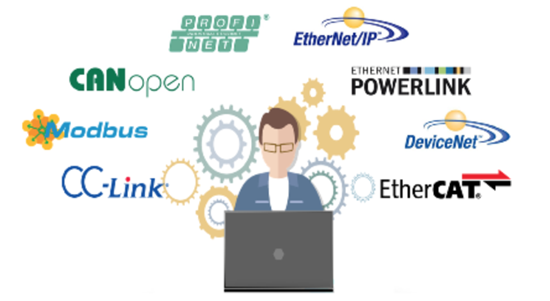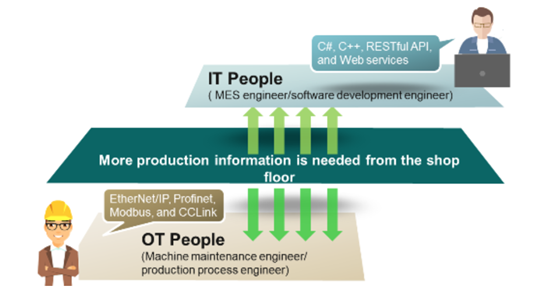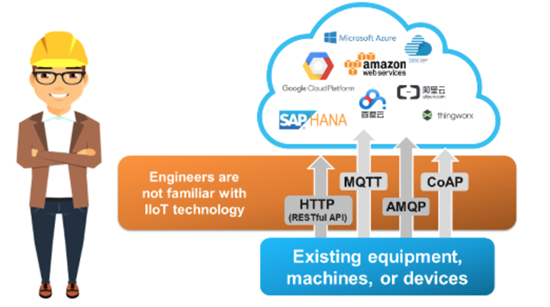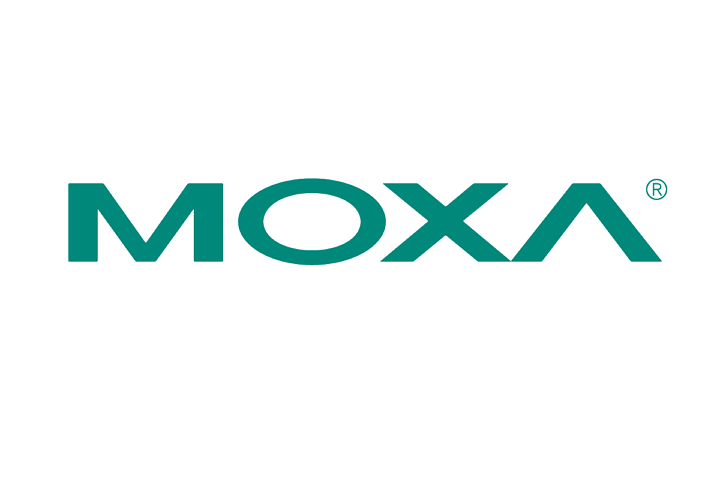Integration specialists (ISs) frequently struggle to establish connections across the diverse platforms within a network. At the core of this issue lies the extensive range of protocols in the three distinct fields of network structure: Operational Technology (OT), Information Technology (IT), and the Industrial Internet of Things (IIoT). Each field possesses its unique array of protocols, creating isolated environments that hinder the transmission of valuable data essential for enterprise-level decision-making. The challenge is further exacerbated by the lack of familiarity between the OT and IT departments regarding each other’s protocols. It is evident that these departments can no longer function independently, as the convergence of OT and IT technologies becomes more prominent with the integration of IIoT into automation.
OT-to-OT Compatibility
Following the rise of IIoT, communication between OT systems in factories has significantly intensified owing to the abundance of sensors and machines connected to the Internet. This increased operational intricacy has led to a proliferation of heterogeneous systems on the factory floor within the OT domain. These diverse OT systems—including Manufacturing Executive Systems (MESs), Supervisory Control and Data Acquisition (SCADA) systems, Programmable Logic Controllers (PLCs), and the machinery and sensors on the plant floor—all operate on distinct protocols, resulting in interoperability challenges and necessitating numerous protocol conversions.
For ISs, this translates to prolonged planning phases for architectural setup and device deployment. However, ISs aim to streamline the device commissioning process, avoiding extensive time spent on protocol conversions and configurations. What they seek is an efficient method to simplify protocol conversions, allowing them to focus their limited time on core activities like programming.
A convenient solution to facilitate mass device configurations and protocol conversions involves employing a pre-configured protocol gateway that supports various industrial protocols commonly used in OT, such as PROFINET, PROFIBUS, Ethernet/IP, and Modbus. This gateway streamlines protocol conversions, resulting in significant time and cost savings.

OT-to-IT Compatibility
Efficient collaboration between the IT and OT departments is crucial to fully leverage the IIoT platform of any intelligent application. IT departments face increasing demands to gather data from shop floors for production optimization. For IT personnel, this proves challenging as they are unfamiliar with collecting data via industrial protocols. Concurrently, OT employees encounter similar difficulties when transferring OT data to the IT layer, given that IT departments often require unfamiliar protocols.

To bridge the gap between OT and IT effectively, a smart I/O supporting various protocols (such as Modbus/TCP and Ethernet/IP for Industrial Automation (IA) specialists, and SNMP and RESTful API for IT professionals) becomes crucial. This solution enables convenient data retrieval for both IT and IA specialists from the same I/O device.
OT-to-IIoT Compatibility
The primary objectives of data analysis and mining are to reduce operational costs, optimize production, and enhance predictive maintenance to minimize downtime. Initially, data must be gathered from field locations and then transmitted to the cloud for storage and analytics. It is the responsibility of OT engineers to transfer this data from the field to the cloud. This additional task extends beyond their comfort zone, given their limited IT expertise. Transferring data from an edge device to the cloud can be time-consuming, compounded by the OT engineers’ lack of IT knowledge, further complicating the process.

To streamline programming efforts, minimize time and costs, an embedded computing platform supporting versatile interfaces, in combination with a software suite integrating a pre-configured Modbus engine and cloud connections like AWS, allows rapid integration between field devices and the requisite IIoT applications. Additionally, for those opting for OPC US adoption for unified automation interfaces, a software suite solution is available providing both an OPC UA server and cloud connectivity capabilities. Notably, this solution incurs no additional costs for implementing extra architecture for cloud connectivity.
Moxa’s Solutions
For detailed information about Moxa’s extensive range of solutions to streamline interoperability in factory automation, kindly visit our website.
- Not Only for Automobiles: Discovering CANbus Technology in Various Industrial Settings - October 29, 2024
- Boost Your Network Performance: An Exciting Manual to PoE Switches! - September 10, 2024
- Understanding Gigabit Switches: Industrial vs Regular Gigabit - September 4, 2024


